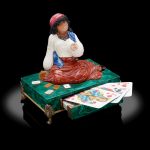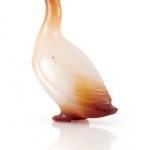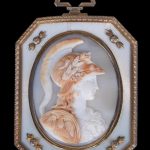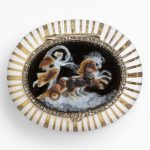Information on The House of Faberge and gallery of items including cameos made by the firm. The House of Fabergé is a jewellery firm founded in 1842 in St. Petersburg, Imperial Russia, by Gustav Faberge, using the accented name “Fabergé”. Gustav was followed by his sons Peter Carl Fabergé and Agathon Fabergé Sr. and grand sons, until the firm was nationalised by the Bolsheviks in 1918. The firm has been famous for designing elaborate jewel-encrusted Fabergé eggs for the Russian Tsars and a range of other work of high quality and intricate details. In 1924, Peter Carl’s son’s Alexander Fabergé and Eugène Fabergé opened Fabergé & Cie in Paris, making similar jewellery items, but adding the city to their rival firm’s trademark as “FABERGÉ, PARIS”. In 1937, the rights to the brand name “Fabergé” was sold to for the marketing of perfume to Samuel Rubin. It was then re-sold in 1964 to cosmetics company Rayette Inc., which changed its name to Rayette-Fabergé Inc. As the name was resold more times, Fabergé companies (such as Fabergé Inc.) launched clothing lines, the cologne Brut (which became the best-selling cologne at the time), the perfume Babe, hair products, and undertook film production. The brand name changed hands a few more times and jewelry was eventually added back to the products under the name. Next to branded Fabergé products the world market has been continuously supplied with so called Fauxbergé items and ‘Fabergé style’ products. Today the brand is solely used for jewelry and gem stones.
In 1885, Tsar Alexander III commissioned the House of Fabergé to make an Easter egg as a gift for his wife, the Empress Maria Fedorovna. Its “shell” is enamelled on gold to represent a normal hen’s egg. This pulls apart to reveal a gold yolk, which in turn opens to produce a gold chicken that also opens to reveal a replica of the Imperial Crown from which a miniature ruby egg was suspended. Although the Crown and the miniature egg have been lost, the rest of the Hen Egg as it is known is now in the collection of Victor Vekselberg.
The tradition of the Tsar giving his Empress a surprise Easter egg by Carl Fabergé continued. From 1887, it appears that Carl Fabergé was given complete freedom as to the design of the Imperial Easter eggs as they became more elaborate. According to the Fabergé Family tradition, not even the Tsar knew what egg form they would take: the only stipulation was that each one should contain a surprise. The House of Fabergé completed 50 Imperial eggs for Alexander III to present to his Empress and for Nicholas II to present to his mother, the Dowager Empress Maria Fedorovna and his wife the Empress Alexandra Fedorovna.[3] Of these, 43 are known to have survived.
Published Gemstone Carving: The Gypsy Fortune Teller By Chubuanco For the House of Fabergé Jewelry Salon St. Petersburg, Russia A functional box which can be used to store a deck of cards, with concealed closure for the drawer. The blouse of the fortuneteller is carved of white kascholong opal from the Caspian Sea; the box, is carved of malachite; the scarf of red jasper; the face of eosite quartz; the scarf of lapis lazuli. The yellow gold cards are decorated with enamel. With sterling silver mounts. This is a unique gemstone sculpture, made in an edition of one. Height 6in
Sold for US$ 11,875 (£ 9,013) inc. premium at Bonhams in 2018
A RARE SILVER-GILT AND CLOISONNÉ ENAMEL ICON OF THE MOTHER OF GOD ELEUSA MARKED K. FABERGÉ WITH THE IMPERIAL WARRANT, OVERSTRIKING THE MARK OF FEODOR RÜCKERT, MOSCOW, 1908-1917, SCRATCHED INVENTORY NUMBER 33671 Oval, realistically painted, the halos and oklad cloisonné enamelled with geometric motifs and stylised foliage in shades of green, turquoise, and purple on blue ground, with possibly later wood back, marked on lower mount 4 5/8 in. (11.7 cm.) high
Sold for GBP 93,750 at Christie’s in 2018
Fabergé Agate Model of a Goose St. Petersburg, circa 1900 Realistically carved, with rose-cut diamond eyes. Height 3 1/8 inches (8 cm). Provenance: Christie’s Geneva, 11 May 1982, lot 256 (part) Christie’s, New York, April 20, 2001, lot 64 Acquired at the above sale by the present owner Exhibited: Munich, Kunsthalle der Hypo-Kulturstiftung, Fabergé Hofjuwelier der Zaren, December 5, 1986 – February 22, 1987, No. 293. Literature: Géza von Habsburg, Fabergé Hofjuwelier der Zaren, Munich, 1986, p. 193. The prototypes of Fabergé’s hardstone miniature sculptures of animals were, according to Franz Birbaum, senior master craftsman for Fabergé, Chinese and Japanese gemstone carvings (F. Birbaum, The History of the House of Fabergé, St. Petersburg, 1992, p. 42). In fact, a strong Asian current can be felt throughout Fabergé’s production, from hardstone animals and flower studies to silver. Carl Fabergé himself was an admirer and avid collector of Japanese netsuke, and the precision of detail and similarities in modeling between netsuke and Fabergé’s animals is immediately apparent. The Asian influence on Fabergé’s production of hardstone animals can be seen in the present lot. Two animals held in the Kremlin Armoury in Moscow show a similar influence: a carnelian model of a fish and a carnelian fly-shaped toilet case (T. Muntian, The World of Fabergé, Moscow, 2000, Nos. 33-34, p. 69). Further examples include a bowenite model of a sparrow (From the Collection of King George I of the Hellenes, Christie’s, London, January 24, 2007, lot 370) and a nephrite model of a dragonfly from The Woolf Family Collection (The Walters Art Museum, The Fabergé Menagerie, Baltimore, 2003, No. 116). The Russian Imperial Family were avid collectors of Fabergé’s hardstone animals, including those with Asian influences. In February 1904, Dowager Empress Maria Feodorovna purchased four models of geese from Fabergé, two carved from carnelian and two from Japanese agate (R.R. Gafifullin, Works of the Fabergé Firm, Late XIX — Early XX Century in the Collection of the State Pavlovsk Museum, St. Petersburg, 2013, Nos. 1328-1329, 1331, p. 121). In December 1902, Emperor Nicholas II and Empress Alexandra Feodorovna jointly purchased a Japanese goose carved from agate (R.R. Gafifullin, op cit, No. 4657, p. 255).
Sold for $20,000 (includes buyer’s premium) at Doyle New York in 2018
This silver-gilt and glass vase is one of a very few examples that represent the collaboration between Louis C. Tiffany and Tiffany & Co. in New York, Edouard Colonna in Paris, and the workshops of Fabergé in St. Petersburg, Russia. Tiffany glass with Fabergé mounts are very rare, and this exquisite example is particularly special in that it has its accompanying design drawing, a beautifully rendered watercolor (2014.698.1). The blown-molded vase in Tiffany’s trademark Favrile glass exhibits the artist’s signature turquoise color, further enhanced with pulled threaded decoration. The overall iridescence and luster are complemented by the ornate silver mounts in the form of intertwined snakes. The mounts are composed of two snakes on the rim and three on the base, each writhing and twisting around themselves. Expertly designed to create this imaginative work of art, the snakes at the rim appear to be crawling inside the vase while the lower mount rests upon the three snakes’ heads.
Reference: The Metropolitan Museum of Art
Cigarette case in presentation box, gold / diamonds / guilloche enamel / wood / satin / velvet, August Hollming, Fabergé, St Petersburg, Russia, 1896-1908 Made by House of Faberge in Russia Rectangular gold cigarette case. The hinged cover has engine-turned star burst pattern under transparent,opalescent pink enamel (guilloche). It is applied in the centre with cast gold Imperial Eagle set with a diamond. A push clasp on the side of the case is also set with a diamond.The inside cover is highly polished gold and there are two elastic bands to secure the cover in place. The presentation box is crafted from a light blonde wood, has hinged lid and a small clasp at the front. The top left hand corner has applied the same State Emblem in cast brass set at an angle, the box has rounded corners. The base of the interior has a recess for the cigarette case and is lined in cream velvet. The cream satin lining of the lid is is printed with makers mark in gold consisting of an Imperial eagle at the top and Russian text below which translates to ‘FABERGE/St Petersburg/Moscow, Odessa’.
Reference: Museum of Applied Art and Sciences
Lapidary artists in the Fabergé workshops employed a wide range of semi-precious stones to create exquisitely carved animal sculptures. Their selection, and the manner in which the stones were employed, depended upon the design and in many cases imitated patterns and hues found in nature. Some of the animals, including this bulldog, were actual portraits of living creatures that were prized pets. Both the name and address of the dog represented here (Cody, Av. Bosquet 9) are inscribed on an applied gold plaque secured to the dog’s bejeweled collar. This ornament also features a diamond-studded buckle, a polished gold bell in the front, and a ring at the back for a leash. Cody’s arresting eyes are cabochon rubies set in gold and his body is made of tan-colored agate. The ears are slightly darker in color and the skin folds, fur, and posture are highly naturalistic.
The sculpture of Cody was a gift to actress Elizabeth Balleta from Grand Duke Alexei Alexandrovich, son of Alexander II and a high admiral in the Russian Imperial fleet. Ms. Balleta, who performed for many years at the Imperial Theater in St. Petersburg, was a favorite of the Grand Duke who often purchased gifts for her from Fabergé and Cartier. After twenty-five years of acting, she settled in Paris at Avenue Bosquet 9. Many of Fabergé’s carved animals were made in Idar-Oberstein, Germany and at the Imperial Peterhof Lapidary Works in St. Petersburg. After 1908, with the arrival of such lapidary artisans P. Kremlev and P. Derbyshev, the firm produced its own works in hard stones.
Lapidary artists in the Fabergé workshops created exquisitely carved animal sculptures from a wide range of semiprecious stones, matching the natural color and inclusions of particular gems with their designs.1 Some of the sculptures were portraits of prized pets. This highly naturalistic carved agate bulldog has his name and address—”Cody, Av. Bosquet 9”—engraved on a plaque soldered to his jeweled collar. The neck ornament also features a diamond-studded buckle, a polished gold bell, and a ring at the back for a leash. The dog’s arresting eyes are cabochon rubies set in gold.2 Yvonne J. Markowitz, “The Balletta Bulldog” in Artful Adornments: Jewelry from the Museum of Fine Arts, Boston by Yvonne J. Markowitz (Boston: MFA Publications, 2011), 93.
Reference: Museum of Fine Arts Boston
An Imperial Presentation Fabergé jewelled gold and enamel box, workmaster Michael Perchin, St Petersburg, 1897 of rounded rectangular form, the lid centred with the diamond-set crowned cypher of Emperor Nicholas II on a ground of translucent white enamel over sunburst engine-turning within a diamond frame, within an openwork panel chased with two opposing griffins rampant bearing swords, their shields set with large circular-cut diamonds, within bandwork and foliate scrolls and volutes, the ground of translucent red enamel over banded wavy engine-turning, the lid border of pink and green gold husks and beads, the corners set with diamonds, the sides reeded horizontally, the base and lid borders of chased green gold leaf trails, struck with workmaster’s initials (his early mark on the flange, his later mark on the base and lid) and Fabergé in Cyrillic, 56 standard width 10.6cm, 4 1/4 in.
Sold for 200,000 GBP at Sotheby’s in 2018
Oval gold bonbonnière, with bands of white enamel and gold, the hinged lid with a layered agate cameo carved with Aurora in her chariot within rose-cut diamond border. The cameo is 19th century in date.
The strong design of this bonbonnière is original. Some of Fabergé’s boxes are clearly indebted to eighteenth-century century prototypes, such as the Rococo or Neo-classicism. The cameo shows Neo-classical influence, as does the oval shape, but the rounded sides and rayed decoration in enamel are a late nineteenth-century development. Mikhail Perkhin, whose mark is struck on the inside of the box, was Fabergé’s head workmaster from 1886 until his death in 1903.
Reference: © Victoria and Albert Museum
This tiny diamond-eyed anteater was purchased by Henry Walters, founder of the Walters Art Museum, on a trip to St. Petersburg in 1900. The House of Fabergé began making hardstone animals in the 1890s and they proved popular with their elite clients. Queen Alexandra (wife of the British King Edward VII) built a large collection, and production peaked in the years immediately before the outbreak of the First World War in 1914. Objects such as this anteater were inspired by Japanese netsuke. Carl Fabergé owned over 500 of these. He married this admiration of Asian art with the rich Russian tradition of hardstone carving. The anteater is unusual among Fabergé’s menagerie, although examples in bloodstone and quartz are also known.
Reference: The Walter Art Museum
Amongst Fabergé’s more popular creations were the miniature hardstone carvings of people, animals and flowers carved from semi-precious or hardstones and embellished with precious metals and stones. The most common animal carvings were elephants and pigs but included custom made miniatures of pets of the British Royal family and other notables. The flower sculptures were complete figural tableaus, which included small vases in which carved flowers were permanently set, the vase and “water” were done in clear rock crystal (quartz) and the flowers in various hardstones and enamel. The figures were typically only 25–75 mm long or wide, with some larger and more rare figurines reaching 140–200 mm tall, and were collected throughout the world; the British Royal family has over 250 items in the Royal Collection, including pieces made by Michael Perkhin and Henrik Wigström. Other important Fabergé miniature collectors were Marjorie Merriweather Post, her niece Barbara Hutton and even Fabergé’s competitor Cartier, who in 1910 purchased a pink jade pig and a carnelian (agate) fox with cabochon ruby eyes set in gold. Reference: Wikipedia













